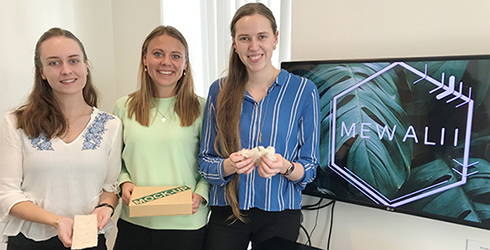
Students develop sustainable sanitary towels from plants
Three students were tired of not being able to find sustainable sanitary towels. So, they developed one from plant fibres that is just as absorbent as conventional sanitary towels. Now they are looking for patents and investors.
Three environmentally-conscious students from the University of Southern Denmark noticed that it is impossible to find sustainable sanitary towels and tampons in stores. So, now they have developed a disposable sanitary towel from sustainable plant fibres.
‘Our tests show that it works. The sanitary towel is just as absorbent as conventional sanitary towels’, says Emilie Søby Eriksen, looking at the piece of fabric made of compressed plant fibres lying on the table.
‘Three grams of plant fibres, which is what one of our sanitary towels typically contains, absorbs 50 grams of liquid. During a typical menstrual period, women bleed an average of 50 grams of fluid throughout the entire menstruation, so the sanitary towel fully meets normal needs’, says Simone Westergaard.
Climate-impacting
70 per cent of all sanitary towels on the market consist of plastic fibres. This affects the climate because plastics consist of petroleum. In traditional sanitary towels, cotton is the absorbent material. Cotton is very damaging to the climate because roughly 5,000 litres of water are needed to produce one kilo of cotton.
‘I am very focused on sustainability, but when it comes to menstruation, I do not feel I have the option of making a sustainable choice that also meets my demands for comfort and hygiene’, says Frederikke Dahl.
So, the three students, Frederikke Dahl, Simone Westergaard and Emilie Søby Eriksen, took the matter into their own hands. They created the start-up Mewalii, where they dream of selling sustainable disposable sanitary towels (and eventually tampons) via a subscription scheme.
Cup or fabric towel?
For over half a year, Simone Westergaard, Frederikke Dahl and Emilie Søby Eriksen studied scientific articles and were in the lab studying the absorbency of various plant fibres. They investigated water consumption and chemical consumption.
‘Obviously, one can use menstrual cups or fabric towels. I use the menstrual cup myself, but it doesn’t stay very tight’, says Emilie Søby Eriksen, while Frederikke Dahl and Simone Westergaard have given up on using the cup.
‘And we have not used the fabric towels. We all agree that it is not convenient to have used sanitary towels lying in a bag until we can get home and boil them. At the same time, you might wonder how sustainable the sanitary towels ultimately are if they have to be boiled’, says Frederikke Dahl.
Uses a lot less water
Frederikke Dahl and Emilie Søby Eriksen are recently graduated BEng in Integrated Design and have had the opportunity to do product development on their sustainable sanitary towels as part of their final project.
‘The most important thing is the sanitary towel’s comfort and absorbency, and by testing different options, we found that a specific bast fibre has the best absorbency. The fibres come from the long stems of plants such as nettles’, explains Emilie Søby Eriksen, adding:
‘We don’t say precisely what the plant fibres are. We are applying for a patent and are afraid someone will take our idea.’
Did you know?
- Throughout a woman’s life, she uses between 5,000-15,000 disposable hygiene products.
- On average, a woman menstruates for 3,000 days in her life, or the equivalent of 8 years.
- In the U.S., two independent studies were done on female strippers and waitresses showing that during their ovulation, they receive twice as many tips as they would otherwise.
‘We went and tenderised the stems ourselves so we could pull off the bast threads’, says Frederikke Dahl, pointing to a jar with the processed plant fibres sitting there like small beige wads of cotton.
But besides the absorbency, it is the sanitary towel’s total climate impact that the women are keeping an eye on.
‘It is crucial to us that the plant fibres grow in Europe, so we avoid long shipping. Also, five times less water is needed for our plant fibres than cotton’, Emilie Søby Eriksen points out.
Looking for contacts in production
Simone Westergaard, Frederikke Dahl and Emilie Søby Eriksen are bursting with confidence and firmly believe that they have developed a sustainable sanitary towel that lives up to women’s demands for comfort and hygiene.
They now have an office at SDU Cortex Lab, where they try to get in contact with people in the production stage in order to produce finished samples.
‘In any case, we think we are at a point where we have a product with a lot of potential. Now we have to get a patent, put it into production, and then we have to convince investors that we have a really good business here. But we’ve simply encountered so much goodwill and help, so we really believe in it’, says Simone Westergaard.
Meet the students

Frederikke Dahl is a recently graduated BEng in Integrated Design and, together with Simone Westergaard, had the idea to develop sustainable disposable sanitary towels..
Emilie Søby Eriksen is a recently graduated BEng in Integrated Design. She became the third member of the start-up Mewalii after she and Frederikke Dahl did product development on the sustainable disposable sanitary towel in their final project.
Simone Westergaard studies Sports and Health. She originally had the idea of selling sanitary towels and tampons through a subscription plan, but after she met Frederikke Dahl at SDU’s talent programme in entrepreneurship, they got the idea for sustainable disposable sanitary towels together.
- Read more: BEng in Integrated Design
- Read more: The Bachelor's degree programme in Sports and Health
- Mewalii’s Facebook-page